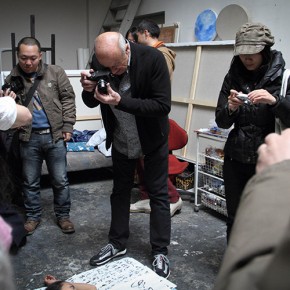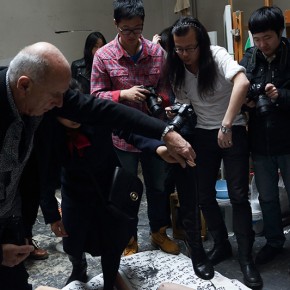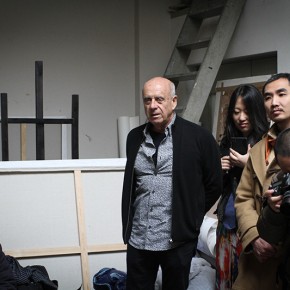
Invited by the Department of Oil?Painting,?CAFA, Ralph Gibson, the noted American contemporary photographer began his last day of academic exchange activities at CAFA, on March 27, 2013.
About half past ten in the morning, Ralph gave a lecture at the 4th Grade classroom of the Department of Oil Painting, different from the previous lecture courses, Ralph chose the way of shooting the scene by reviewing the photographic works of the students, revealing a more profound charm of photography.
Nude and Easel
Ralph let the model stand leaning on the easel, by finding the ratio relationships between the light and shadow, easel and model to investigate how to shape the curves of the body, and how to compose, as well as the establishment of a proper contrast of light and shadow. Ralph said: “I have no idea about what I’m looking for, but when I see something, I’ll recognize the meaning, we have to initially see with the eyes, and secondly use cameras to shoot.” When talking about the differences between the observation and photographs, Ralph said, it was a common experience for everyone, the consistency between the actual shooting and imagination was interrupted, however, we had no idea where it was. He pointed out that it often happened when using a telephoto lens, so he would like to use a 50 mm lens, which would have the most perfect perspective, without deformity.
Human Body and Calligraphy
Ralph went to another classroom, made a model lie on the ground which was covered by calligraphic works, looking for the link between the nude and the calligraphy. The shape was changed according to the slow motions of the nude, during this process, Ralph personally shot using his camera. He said he was looking for a relationship between calligraphy and body posture, especially the relationships between calligraphy strokes and the body, finding the relationships between the hairs and the calligraphy strokes, the brightness-and-shadow of the light and color of the skin, as much as possible.
Ralph said: “Now, each of you can shoot a good photo since I have set a good posture.” And he reiterated two key points: firstly the light, secondly the posture.
Ralph reviewed the photography shot at the scene by the students, and said he liked neat things, and pointed out that photography as a medium, one should learn something from the mistakes. “I have worked in the darkroom for 55 years, until now, I still absorb knowledge from my mistakes, when I criticize your photos, it does not mean it is bad, but you can still learn some knowledge.”
How to take a good photograph? Ralph said, it was very important to grasp the scale of the background of the photo, in addition to “l(fā)isten to” the sound of the light, which could be adjusted in the darkroom. In addition, Ralph noted that observing the photo again could inspire the photographers. “If you can sit in front of your works to see and think for three hours, I believe, you can become a better photographer. You could learn something that others could not teach you from your own works.”
Human body, Boot and Mirror
In the teaching process, Ralph had transformed the postures of the models and auxiliary props. Finally, two models lie down together, he said: “It’s difficult to shoot one model, and more difficult when there are two.” In addition, a boot hung above the model, this special combination is his usual style, this is what he finds very interesting. Subsequently, Ralph brought a mirror. He said, the juxtaposition of the mirror and nude was a very old trick in photography, some factors such as the position of the mirror, the distance between the mirror and the nude, light and the colors of human skin, etc., were worthy of note.
In addition, Ralph also talked about shooting the human body and architecture as this is essential to a photographer, observing the shapes of the human body and architecture, one had to observe and follow the light. The human body as an object is the most primitive object, Ralph hoped the students would look at the original sculpture, such as “Venus of Willendorf”. These prehistoric sculptures of 25,000 years reflected how humans started to deal with the human bodies, the human body as the mirror of the soul, through which you can see humanity. The human body was perfect, with the presence of light, and each person has a beautiful place. Ralph said he rarely shot the full human body, instead, he was always looking for his favorite details, and eager to see the new shape of the body.
After the end of the course, Ralph answered the questions from the students.
What do you think about the relation between the exaggerated postures of the characters in the classical paintings and the real human body?Ralph: It is a good question. It is a painting that is never too hyperbolic. I set a posture based on the shape I want to find. You need to learn to master various shapes, the body as a “vocabulary”, seen from different angles you can find different shapes, the same as different vocabulary expresses different meanings.
Your photography is mainly black and white, how do you deal with color?Ralph: I decide what I do, if I go to shoot something else, I might consider color. Today, I photographed the relationships between calligraphy and human skin, which would be performed best in black and white. The point of departure of today is the performance of the paper, ink, body hair, and the color of skin. When I went to the Palace Museum yesterday, the point of departure was the search for red, which is similar to the red of a place in Roma, I believe that there is a potential relationship between this red and Chinese culture.
Guitar Performance
At half past six in the evening, Ralph had an artistic performance entitled “Music?for?lens?and?guitar”, at the International lecture Hall of CAFA Art Museum, presided over by Prof. Xie Dongming, Dean of the Department of Oil Painting, Vice President of School of Plastic, CAFA. With a guitar performance, photography and music were fused, giving the audience a visual feast.
Journalist: Yu Ya, Translation: Chen Peihua/CAFA ART INFO
Photography: Hu Zhiheng/CAFA ART INFO







































